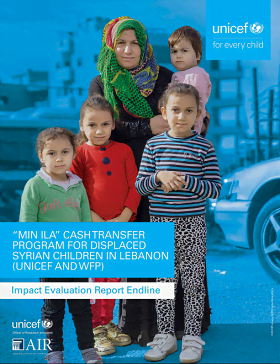“Min Ila” cash transfer program for displaced Syrian children in Lebanon
“Min Ila” is a cash transfer program that was implemented by UNICEF and the United Nation’s World Food Program (WFP) in coordination with the Ministry of Education and Higher Education (MEHE), between 2016 and 2018 covering two (and later three) Lebanese governorates. The program, also known as “No Lost Generation” (NLG), was aimed at reducing financial barriers to the school enrollment and attendance of vulnerable children aged 5-14, and at promoting broad wellbeing, specifically of refugees from Syria attending second-shift schools. The design of the pilot paid special attention to children above the age of ten with an aim to reduce negative coping strategies such as child labor and early marriage.
To understand the effects of the program, UNICEF contracted the American Institutes for Research and UNICEF’s Office of Research to undertake a rigorous, mixed methods impact evaluation (IE) that compares beneficiaries in the pilot governorates to those that would have been be eligible but live in governorates outside the program’s regional coverage. The IE used a geographic regression discontinuity design (RDD), following 1,440 households located near the border that separates program and nonprogram governorates, and collected baseline, midline and endline data to assess the effects of the program on children’s school enrollment and participation, in addition to broader child well-being indicators.
Results presented in the IE showed that NLG/Min Ila improved children’s food consumption, physical health, lowered child engagement in work for the household, improved indicators of children’s subjective well-being, noting the causal link between these dimensions and child education outcomes. The IE’s midline evaluation also showed increased rates of school attendance, although the endline evaluation found little evidence for increased child enrollment owing to supply-side restrictions, whereby second-shift schools had already been operating at capacity at the start of the program.
The impact evaluation was one of the first of its kind in terms of assessing the effectiveness of child-focused education cash transfer programs in challenging refugee settings.
